ABSTRACT
In this age of ubiquitous advertisement, people are getting more and more burdened with advertising clutter. Digital Signage (DS) has evolved to be a new medium that can cut through this clutter and reach a large number of consumers. Though Digital Signage was introduced as an in-store advertising medium, soon it started to replace traditional static billboards with the benefit of technological advancement.
While advertising effectiveness is a much discussed subject, effectiveness of an advertising media is still a less explored area. Our research explored the effectiveness of Digital Signage as an advertising media in terms of its placement inside of a store and outside of a store. At the beginning we developed a model to measure the effectiveness of Digital Signage on the basis of an existing model, termed as Advertising Response Model (ARM).
Based on profound study and analysis of previous literature on advertising and media effectiveness, consumer psychology, outdoor advertising and intermediate measurement variables we constructed the modified version of ARM that deemed to be the best fit with our purpose. We further developed four hypotheses on the basis of the four major variables of our model.
The result of our study indicated that placement of Digital Signage inside and outside of the store environment impacts the variables of Attention, Recall and Media Liking of the audience differently. However, no significant difference in consumers’ Buying Interest is supported. Placing Digital Signage inside of the store as well outside of the store both has different degrees of impact on consumers in terms of Attention, Recall and Media Liking. The correlations among the variables were also explored and thus we presented some strategic insights about the placement of Digital Signage and practical implications for managers in the scope of our study.
Our research area has received comparatively less academic attention than other advertising media. However, considering the growing importance of Digital Signage as a groundbreaking advertising medium and scope of future research work, we believe Digital Signage will be a subject of interest for the academics, the advertisers as well as for the companies.
LITERATURE REVIEW
As Figure 1 illustrates the first step for an advertisement regardless of the fact that it will be processed through the central or the peripheral route is to break the advertising clutter and to gain attention. Once it has succeeded in gaining attention it is either processed through the central or the peripheral route.
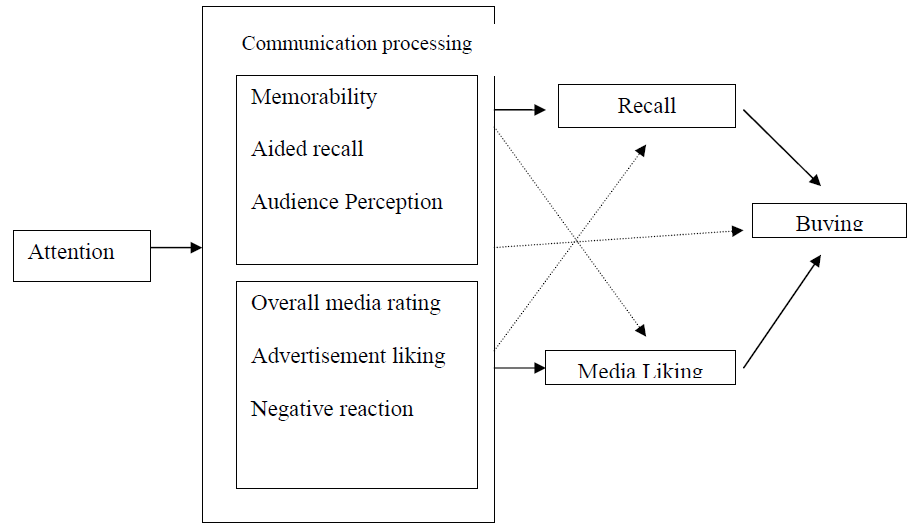
Figure 2: Modified ARM (Own model, created by authors, based on Mehta, 1994, p. 64).
The attitude towards an ad medium is also taking place at a low involvement level because it is connected to the peripheral cue and subjects like medium design, sound, color, etc. A detailed explanation concerning the variables of the modified ARM (recall, media liking, attention and buying interest) as well as appropriate arguments for our choice will be given along the second chapter. The following figure illustrates the modified ARM that will be the basis for the current study.
DIGITAL SIGNAGE

Figure 3: Basic Digital Signage system.
“Digital signage has evolved into a highly efficient, appealing means of providing multimedia contents for business owners, brand marketers, and advertising agencies, who realize its benefits of informing, promoting, and entertaining specifically targeted consumers. The days of providing static content are behind us.”
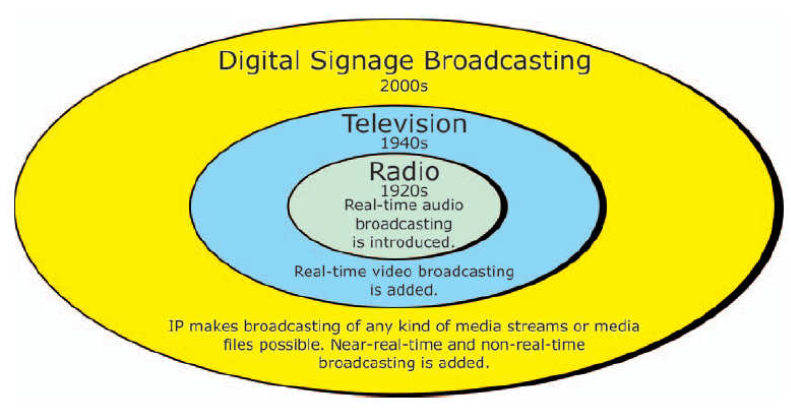
Figure 4: Evolution of Media.
Lundstrom (2007, p. 8) went even further to say that Digital signage is going to be a new medium that encompasses live radio and television as well as real time and non-real-time presentations of media files. He argued, digital signage systems comprise audio, video, and all other kinds of information in real time, near-real time, and non-real time. These systems may make use of broadcast distribution and may then be regarded as a new kind of medium beyond television (Lundstrom, 2007, p. 9). The evolution of advertising media according to Lundstrom is presented in the following figure.
METHODOLOGY
This chapter is going to provide the philosophical underpinnings, the methodological framework and practical research methods. We explain which approaches in terms of ontology and epistemology we have chosen and argue for our choices. Furthermore, issues concerning our data collection such as sample size, location, respondents etc will be addressed. Finally the chapter will close discussing the Validity and the Reliability of our methodological approaches.
So, our focus is on the location of digital signage and its impact on consumer’s buying intention. To make it simpler, we can say that we would like to identify and compare the effectiveness of digital signage while it is placed inside and outside a store. As we used intermediate variables (attention, recall, media liking and buying interest) to measure the effectiveness, the analysis will address more questions such as – do consumers perceive digital signage differently in different locations? How the measurement variables are correlated? How the audiences perceive digital signage as an advertising medium? And what placement strategy can be optimal for digital signage.
EMPIRICAL FINDINGS
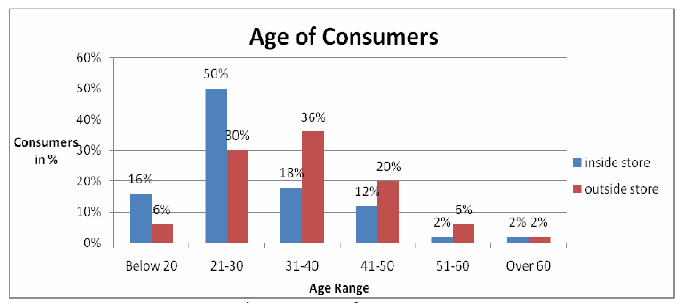
Figure 5: Age of Consumers.
We choose these variables because we aim at figuring out possible connections between consumers’ age, gender and income level in terms of paying attention to advertisement messages around them and being opened to buying options. The importance of these connections is related to the fact that – as already explained – buying intention is represents an important determinant for effectiveness and that buying intention cannot be created if the mandatory variable of attention is not given.
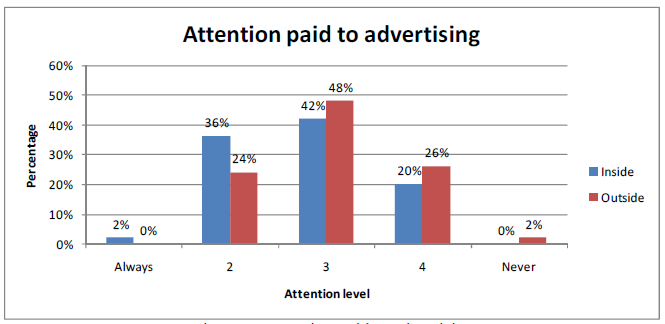
Figure 7: Attention paid to advertising.
The following four variables of ‘attention paid towards advertising messages’, ‘general attitudes towards advertising: useful’, ‘general attitude towards advertising: disturbing’ and ‘perception of advertising clutter’ are the factors that are going to be taken into consideration for an overall rating of the general attitude that consumers have towards advertising.
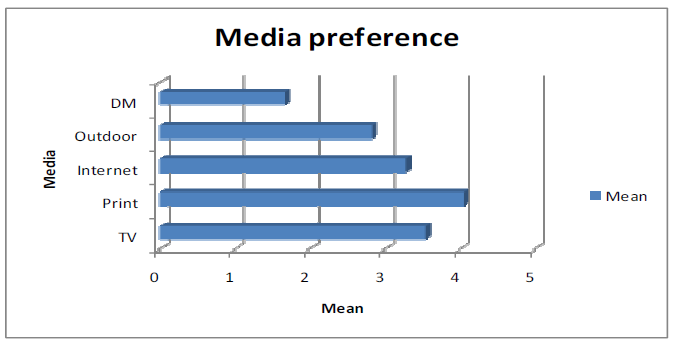
Figure 11: Media Preference.
The following graph illustrates the values of the variable of ‘Media preference’. This variable describes consumers’ general preferences concerning the most frequent media in the advertising market through which advertisements are distributed. We have chosen this variable because we would simply like to give an overview of the most and the least preferred advertising media.
ANALYSIS
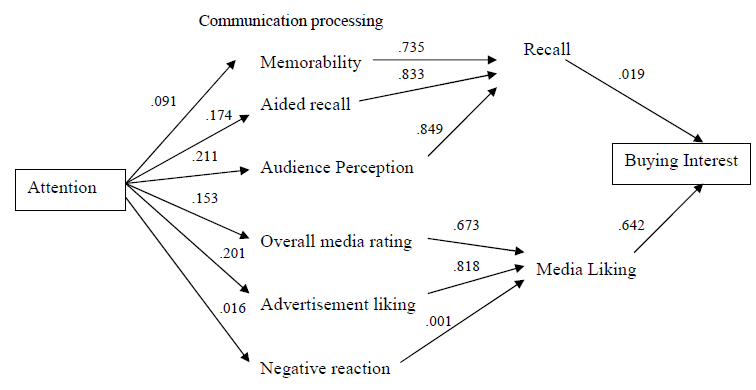
Figure 19: ARM for Digital Signage inside the store.
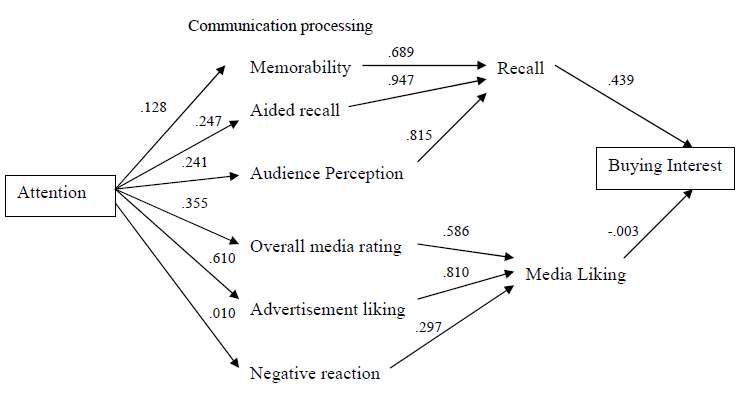
Figure 20: ARM for Digital Signage outside the store.
The modified ARM that we developed to measure and compare the effectiveness of Digital Signage inside and outside the store is presented below with the respective standardized regression coefficients. The coefficients will be explained in the following section with a locational comparison between inside and outside of stores.
CONCLUSIONS
As explained in the Literature Review chapter, previous literature on outdoor media asserts that location is an important factor to maximize the effectiveness of an outdoor display like Digital Signage (reference). Our data and analysis further supports the importance of placing digital signage in appropriate locations. Three important measurement variables of effectiveness were found to be significantly different for the two locations of DS i.e. inside of the store and outside of the store.
Hence, the placement of Digital Signage in terms of inside or outside of the store certainly has strategic implications for the distributors of the media as well as for media planners. Distributors control Digital Signage networks and communicate with the companies who promote their offers on Digital Signage and Media planners decide on the appropriate media mix for promotional campaigns. Besides placement, our study comes up with some other strategically important issues.
Firstly we would like to investigate that when the DS is placed inside of a store, the medium is likely to enjoy more attention, recallability and likability than when it is placed outside of the store, for example beside a street. But it cannot be definitively said that digital Signage should always be placed inside of a store. Placing outside can also produce favorable outcomes in terms of buying interest if the distributor can apply some strategic decisions properly, as our study indicates. These strategic points are discussed elaborately below.
Source: Umea University
Authors: Md Iftekharul Islam | Anahita Dahmalani
